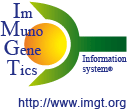Here you are: IMGT Web resources > IMGT Scientific chart >
2 . Numbering
IMGT numbering of additional codons (or amino acids) and corresponding nucleotides
Additional codons (or amino acids) and corresponding nucleotides are identified by a number (the one of a neighbour reference codon) followed by a dot and number, or by a letter:
a dot and number, for expected additional codons (or amino acids)
- C-DOMAIN and C-LIKE-DOMAIN (N-terminal end of stand A; AB, CD, DE and EF turns)
Examples:- codon 1.1 (nucleotides 1.1, 2.1, 3.1)
- codon 1.2 (nucleotides 1.2, 2.2, 3.2)
- codon 1.3 (nucleotides 1.3, 2.3, 3.3)
- codon 45.1 (nucleotides 133.1, 134.1, 135.1)
- codon 45.2 (nucleotides 133.2, 134.2, 135.2)
- codon 84.1 (nucleotides 250.1, 251.1, 252.1)
- codon 84.2 (nucleotides 250.2, 251.2, 252.2)
- codon 85.1 (nucleotides 253.1, 254.1, 255.1)
- CDR-IMGT of V-DOMAIN and V-LIKE-DOMAIN
- codon 60.1 (nucleotides 178.1, 179.1, 180.1)
- codon 112.1 (nucleotides 334.1, 335.1, 336.1)
a capital letter, for unusual insertions (or insertions that need to be underlined)
Examples:
- FR-IMGT of V-DOMAIN and V-LIKE-DOMAIN
- codon 84A (nucleotides 250A, 251A, 252A)
The letter can be shown as a superscript for a greater readability (for instance in Tables of alleles)84A for 1 additional position 84A, 84D for 2 additional positions 84A, 84B, 84C for 3 additional positions 84A, 84B, 84C, 84D for 4 additional positions - codon 84A (nucleotides 250A, 251A, 252A)
- codon 84A (nucleotides 250A, 251A, 252A)
Note that
- the "capital letter" and the "dot and number" are identical in the codon numbering and in the nucleotide numbering.
- the codon number which is before the letter or the dot is multiplied by 3 to obtain the
numbering of the third (most downstream) nucleotide of that codon.
The numbering of the second and first nucleotides are obtained by substracting 1 and 2, respectively.



